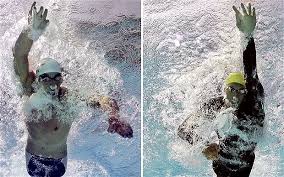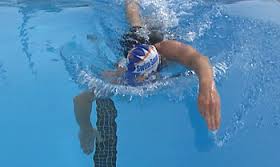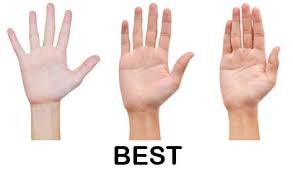There are very few contentious issues in swimming and most of them can be solved by scientifically looking at the evidence. One of the minor issues in swimming is whether to swim with closed fingers or  open fingers. Since humans do not have gills or fins, it is important that we learn how to best use our bodies to get the most out of our strokes. The question about what to do with our fingers and hands makes for an interesting debate and for interesting results. What is the best way to hold the hands?
open fingers. Since humans do not have gills or fins, it is important that we learn how to best use our bodies to get the most out of our strokes. The question about what to do with our fingers and hands makes for an interesting debate and for interesting results. What is the best way to hold the hands?
Paddles or Not?
Your hands are very important in the pool. The difference between open and closed fingers may not seem like that big of a deal, but when races come down to split second finishes, any little advantage can make a big difference. When the fingers are closed, the hand acts like a kayak paddle and when the fingers are open, water can move between the fingers. So, what is the most beneficial position?
Resistance is Key
 If you prefer to swim with your fingers closed, you are actually moving against the water. Your hands are a form of resistance and the drag includes all of your arm, from the shoulder to the fingers. When you think about physics, resistance slows objects down. So closing your fingers and using your hand like a kayak paddle does not increase speed. It might seem you would swim faster because a closed hand should be able to move more water, but you have to work harder to go faster with closed fingers. When you want to move water, you need surface area. With closed fingers, the surface area of the hand extends the length and width of the hand.
If you prefer to swim with your fingers closed, you are actually moving against the water. Your hands are a form of resistance and the drag includes all of your arm, from the shoulder to the fingers. When you think about physics, resistance slows objects down. So closing your fingers and using your hand like a kayak paddle does not increase speed. It might seem you would swim faster because a closed hand should be able to move more water, but you have to work harder to go faster with closed fingers. When you want to move water, you need surface area. With closed fingers, the surface area of the hand extends the length and width of the hand.
Build Surface Area
When you swim with your fingers open, you actually get more surface area. With the fingers open, the surface area actually includes the space between the fingers. So your surface area is wider, but not taller. When it comes to smart swimming, the most powerful hands are not muscularly engaged and purposefully spread. They are relaxed and open naturally. When you swim this way, see if you can notice the water moving between your fingers. You probably cannot and that is just fine. The larger surface area can move more water, but it does it with less resistance.
Stay Balanced
Another benefit to swimming with relaxed hands and open fingers is better balance. We may not think of balance in a swimming pool, but with good balance, your body will move more smoothly through the water. Balance helps with all aspects of swimming, from the stroke to the breath. The more balanced the body is, the better it moves and the less friction and resistance it creates.
Research Proves the Case
When researchers looked the debate and the actual  biology of hand positioning in swimming, they realized that when the fingers were open to a natural level, the fingers acted like webbed hands and added more than 50% force to their strokes. With open fingers, swimmers were able to stay horizontal and actually get higher in the water with more of the body out of the water – thus reducing drag and resistance. When swimmers are higher in the water, they do not have to work as hard to swim fast. It is also better for people to swim with their toes spread slightly, too. If you think of the size of swim fins, it makes sense that a “wider” foot will move the body more efficiently.
biology of hand positioning in swimming, they realized that when the fingers were open to a natural level, the fingers acted like webbed hands and added more than 50% force to their strokes. With open fingers, swimmers were able to stay horizontal and actually get higher in the water with more of the body out of the water – thus reducing drag and resistance. When swimmers are higher in the water, they do not have to work as hard to swim fast. It is also better for people to swim with their toes spread slightly, too. If you think of the size of swim fins, it makes sense that a “wider” foot will move the body more efficiently.
Test It Out Yourself
So, the best way to swim is with the fingers naturally open. If you want to see proof, watch footage of Michael Phelps in the water. His hands are open and relaxed. His fingers are spread. If you need to see if it really does work, test yourself. Time yourself with your hands in both positions and see what lets you swim the fastest.
